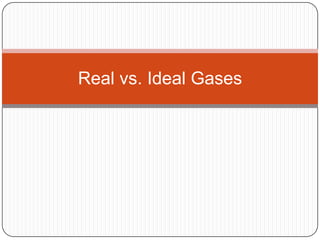Real vs Ideal Gas Properties Compared
•Download as PPTX, PDF•
2 likes•3,364 views
Real gases differ from ideal gases in that real gas particles have volume and collisions are not perfectly elastic, following gas laws only under certain conditions. Real gases can also liquefy under high pressure and have intermolecular attractive forces, while ideal gases are considered to have no volume, perfectly elastic collisions and no intermolecular forces between particles. Ideal gases follow gas laws under all temperature and pressure conditions.
Report
Share
Report
Share

Recommended
Recommended
More Related Content
What's hot
What's hot (20)
Viewers also liked
Viewers also liked (20)
Real vs Ideal Gas Properties Compared
- 1. Real vs. Ideal Gases
- 2. Real Gases If enough pressure is applied, the gas will turn into a liquid. All particles have the same volume. It follows laws under high pressures and low temperatures. The collisions are not elastic. They have polar intermolecular attractive forces.
- 3. Ideal Gases They take up no space. There are no intermolecular attractive forces. Particles are moving in constant, random motion. The collisions are elastic. There is no attraction or repulsion with the container. It follows laws under all conditions of temperature and pressure.